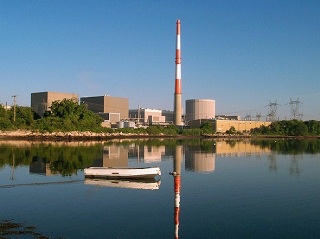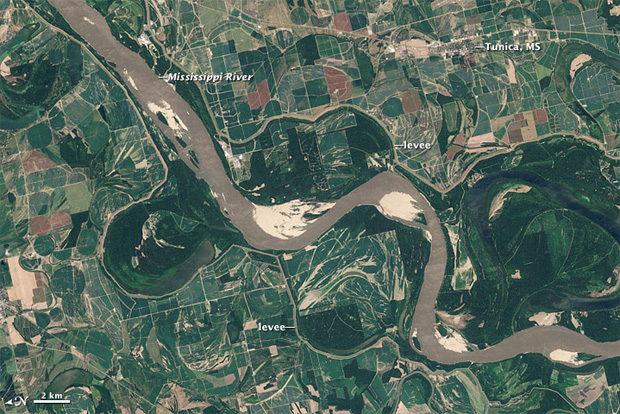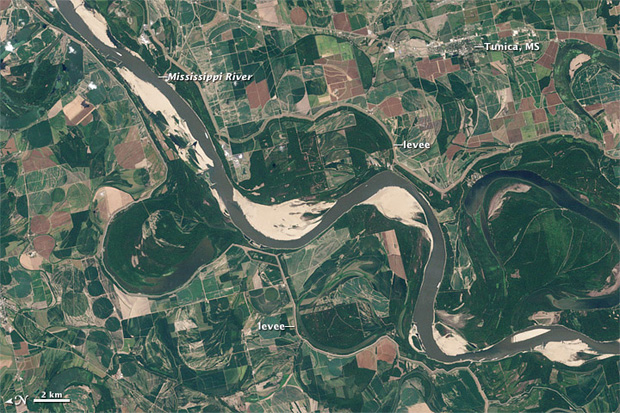The energy-water nexus, 2012 edition
 A blistering summer this year has brought the energy-water nexus into sharp focus: how much power generation depends on water, and how much our water systems depend on power.
A blistering summer this year has brought the energy-water nexus into sharp focus: how much power generation depends on water, and how much our water systems depend on power.We’ve had the hottest July on record in the continental United States, and so far 2012 ranks as the tenth-warmest year on record globally, according to the National Oceanic and Atmospheric Administration.
The heat forced the shutdown of the Millstone Unit 2 reactor at the Dominion Nuclear Connecticut plant in Waterford, Connecticut last Monday, when the water temperature in Long Island Sound reached a toasty 76.7 degrees, over the 75 degree limit for the plant’s cooling water. (As of this writing more than a week later, the reactor is still offline.) I suspect that heat may have played a role in forcing other nuclear plants to shut down in July, by causing electrical component failures. These shutdowns, along with others forced by faulty equipment, have taken U.S. nuclear generation to its lowest level in a decade, according to New Scientist.
The interdependencies of water, power generation, food, and climate are not news. We’ve had shutdowns of power plants due to summertime heat for the past decade or more. But the problem does seem to be getting worse every year.
Water for electricity generation
With the exception of hydroelectric and solar photovoltaic power plants, the core of a utility-scale power plant is essentially the same steam engine technology that was first used to generate electricity by Charles Parsons 125 years ago (which in turn was based on the perfection of the steam engine in 1769 by James Watt, after whom the power unit is named). Heat on one side of the engine causes gas to expand, then the heat is dumped on the cold side of the engine, causing the gas to condense again. The expanding and contracting gas makes the engine spin, turning an array of magnets and electromagnetic coils, which then converts the mechanical energy into electricity.
Water is most commonly used to remove the heat on the cold side. Some power plants are air-cooled, but they are less efficient (particularly in hot weather) because they’re less cold.
According to an excellent, detailed 2006 report by Sandia Labs (Energy Demands on Water Resources – Report to Congress on the Interdependency of Energy and Water), most power plants built before 1970 used an “open-loop” design, withdrawing 25,000 to 60,000 gallons of water per megawatt-hour (MWh) of generation, and discharging nearly all of it back to the source with around 300 gallons per MWh lost to evaporation. After 1970, most plants used a “closed-loop” design, which recycles the water through the plant. These plants withdraw less water — from 300 gallons/MWh for a typical coal plant to 720 gallons/MWh for a typical nuclear plant — but nearly all of it is lost to evaporation.
By those metrics, the 884 MW closed-loop Millstone Unit 2 reactor that shut down last week would consume over 15 million gallons of water per day at full operation.
This makes the thermoelectric power sector — which generates 91 percent of the electricity in the U.S. — one of the nation’s largest water consumers. It accounts for 41 percent of freshwater withdrawals and about three percent of freshwater consumption, where 99 percent of the water used is surface water. According to the Sandia report, thermoelectric power generation in the U.S. consumes 3.3 billion gallons of water per day in total.
When water supply is insufficient (or insufficiently cold), it forces power plants to scale back or shut down altogether. That’s also when power demand for air conditioning is likely to be highest, stressing power transmission lines and creating ideal conditions for brown-outs or grid failures.
When I first reported on the energy-water connection in 2009, I relayed the views of professor Michael Webber of the University of Texas at Austin, who speculated that drought might eventually close nuclear power plants in the Southwest permanently. In an article last week in National Geographic, Webber implied that nuclear plants forced to cut back due to warm water were partly responsible for the deaths of over 10,000 people in the 2003 heat wave in Europe. (I was traveling in Europe that summer, and instead of going from Provence to northern Spain as planned, I bailed out and headed for the French Alps instead to find a little relief. The heat was brutal, and the news from Paris was heartbreaking.)
Water for energy production
The water needed for electrical power generation is vast. But the water demand for producing oil, coal and gas is enormous too, and even less elastic.
Fracking – the process that has brought a fresh boost of oil and gas production to the U.S. in recent years – consumes between 70 and 140 billion gallons of fresh water per year, according to a 2011 report from the EPA. At a typical consumption of 100 gallons of water per person per day in the U.S., that’s equivalent to the needs of two to four million people.
Trying to find reliable data for on the water demand of U.S. corn ethanol production is a short path to utter insanity, with a ridiculously large range of estimates offered. After reviewing a dozen or so academic papers and other sources, I concluded that a 2010 study by the Argonne National Laboratory was in the right ballpark. It estimated that it takes 82 gallons of water on average to produce 1 gallon of ethanol in the regions responsible for 88 percent of U.S. corn production, where the vast majority of that water is used for irrigation. Multiplying that by the 800,000 barrels per day of ethanol production shown in last week’s IEA report suggests that the U.S. currently uses a little over one trillion gallons of water per year to make ethanol. But, as an indication of how widely divergent the estimates can be, a University of Minnesota study found that at the height of the ethanol boom in 2007, “approximately 9.6 trillion gallons of water were appropriated by the U.S. ethanol industry.”
Petroleum refining also consumes a great deal of water: one to two billion gallons per day, according to the aforementioned Sandia study. Perhaps more usefully, the Argonne study puts water consumption for petroleum (which presumably includes water for petroleum extraction using enhanced oil recovery methods) in terms of water consumed per mile by passenger cars. Against 2,025,396 million vehicle-miles traveled by passenger cars in 2010, according to the Federal Highway Administration, the Argonne estimate works out to between 203 and 608 billion gallons of water per year consumed for petroleum.
The Sandia study also addresses the water demands of coal mining, ranging from 10 to 100 gallons per ton of coal mined (1 to 6 gallons per MMBtu). According to the EIA, the US mined 1,094 million short tons of coal in 2011, making the water requirement for coal mining between 10.9 and 109.4 billion gallons per year.
In sum, the freshwater demand of our current production and refining of fossil fuels might be around two trillion gallons per year at the high end.
Energy for water production
The flip side of the energy-water nexus is also challenging. Webber estimates about 10 percent of U.S. electricity is used for waste and wastewater management. But in agricultural areas, it’s much higher. A 2005 study by the California Energy Commission found that one-fifth of the state’s electrical power is used to pump, treat, transport, heat, cool, and recycle water.
That might not seem like a problem yet, but as the Sandia study notes:
“Available surface water supplies have not increased in 20 years, and groundwater tables and supplies are decreasing. Ensuring ecosystem health could further constrain freshwater supplies.
At the same time, populations continue to grow and move to areas with already limited water supplies. Based on current water markets and values, the growth in energy demand, along with stricter environmental regulations on cooling water withdrawals, could double water consumption for electric power generation over the next 25 years, consuming as much additional water per day as 50 million people or more.”
The same dynamics will engender a feedback loop, increasing the demand for electrical power needed to supply fresh water to those people and handle their wastewater.
Water desalination also requires an enormous amount of energy: over 9,800 kWh per million gallons, according to Webber. As energy costs rise, so will the cost of turning saltwater into freshwater.
Water for energy transport
For a final perspective on the energy-water nexus, consider the Mighty Mississippi, which isn’t so mighty this year. Water levels on the country’s inland water transport backbone have reached near-historic lows, forcing barge operators to cut their loads by as much as 25 percent to avoid hitting bottom. In turn, this has increased shipping prices along the river.
A pair of images posted by NASA show how dramatically the river has changed since last year, with huge sandbars now exposed.

Mississippi River, August 14, 2011. Source: NASA

Mississippi River, August 8, 2012. Source: NASA
According to data from American Waterways Operators cited in a recent post at Climate Progress, the Mississippi carries 22 percent of the oil and gas and 20 percent of the coal transported in the U.S.
The U.S. Army Corps of Engineers is working around the clock to dredge the shipping channel along the river, which was silted-in and modified during the historic floods of last year. On Monday this week, an 11-mile stretch of the river near Memphis was completely closed while the work proceeded, and the U.S. Coast Guard reported that about 100 vessels were waiting for passage.
It is feared that the low-water condition could persist through the fall season. If that is the case, it could add a non-trivial cost to the fuels that traverse the river, and slow deliveries to power plants both foreign and domestic, further increasing the pressure on power generators.
Final thoughts
As mentioned earlier, wind power and solar photovoltaics are exceptions to the energy-water nexus. No water is needed to produce power from those sources, and insignificant amounts of water are involved in the production of the equipment. Marine energy, although being fundamentally a water-based technology, does not consume fresh water; it just moves around in salt water. In a warming world, these power sources will have a clear advantage. Conversely, hydroelectric power, being intrinsically dependent on rainfall, makes it an uncertain option in a future of changing climate.
Traditional geothermal plants need water for the cooling cycle, consuming about 1,400 gals/MWh per the Sandia study, as do traditional solar thermal plants, which consume 750 to 920 gals/MWh. Fortunately, there is a trend toward air-cooled designs across the utility sector, and utility-scale solar thermal is one of its fastest-growing segments. The new Ivanpah plant by BrightSource in the Mojave Desert — currently the largest solar plant under construction in the world — is air-cooled.
A final thought: Updating the energy-water nexus story came with the disturbing realization that the data quality on this extremely important subject is poor. Apart from the Sandia report and one or two others, there seems to be a dearth of good, recent studies. Models of how climate change may affect energy and water in the future appear to be virtually non-existent. The available estimates of water demand and their deltas are much too large to be really useful to policymakers or investors, and the time vector is missing altogether. Compared to our data on energy markets, the energy-water data are pathetic.
I don’t know why that is. Perhaps we’re just beginning to discover the hard limits of our energy and water resources and it’s simply a new subject. Perhaps we’re still struggling to get our arms around its complexity. But given our enormously vulnerability and dependency on these systems, we must do better. Government agencies, NGOs, academia, scientific organizations and investors really need to get on the ball to better quantify the challenges in the energy-water nexus, and find ways to produce more energy with less water and more water with less energy.
You can return to the main Market News page, or press the Back button on your browser.

